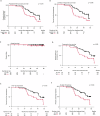Deeper response predicts better outcomes in high-risk-smoldering-myeloma: results of the I-PRISM phase II clinical trial
- PMID: 39753553
- PMCID: PMC11698957
- DOI: 10.1038/s41467-024-55308-5
Deeper response predicts better outcomes in high-risk-smoldering-myeloma: results of the I-PRISM phase II clinical trial
Abstract
Early therapeutic intervention in high-risk smoldering multiple myeloma (HR-SMM) has shown benefits, however, no studies have assessed whether biochemical progression or response depth predicts long-term outcomes. The single-arm I-PRISM phase II trial (NCT02916771) evaluated ixazomib, lenalidomide, and dexamethasone in 55 patients with HR-SMM. The primary endpoint, median progression-free survival (PFS), was not reached (NR) (95% CI: 57.7-NR, median follow-up 50 months). The secondary endpoint, biochemical PFS, was 48.6 months (95% CI: 39.9-NR) and coincided with or preceded SLiM-CRAB in eight patients. For additional secondary objectives, the overall response rate was 93% with 31% achieving complete response (CR) and 45% very good partial response (VGPR) or better. CR correlated strongly with the absence of SLiM-CRAB and biochemical progression. MRD-negativity (10-5 sensitivity) predicted a 5-year biochemical PFS of 100% versus 40% in MRD-positive patients (p = 0.051), demonstrating that deep responses significantly improve time to progression. Exploratory single-cell RNA sequencing linked tumor MHC class I expression to proteasome inhibitor response, and a lower proportion of GZMB+ T cells within clonally expanded CD8+ T cells associated with suboptimal outcomes.
© 2025. The Author(s).
Conflict of interest statement
Competing interests: O.N. reports research support from Takeda and Janssen; advisory board participation for Bristol Myers Squibb, Janssen, Sanofi, Takeda, and GPCR therapeutics; and honorarium from Pfizer. M.B. reports consultancy for Janssen, BMS, Takeda, Epizyme, Karyopharm, Menarini Biosystems, and Adaptive. G.B. reports consultancy for Prothena. E.O. reports advisory board participation and/or honoraria from Janssen, BMS, Sanofi, Pfizer, Exact; consulting for Takeda; and steering committee participation with Natera. K.A. reports consultancy for AstraZeneca, Janssen, and Pfizer; and board participation and stock options for Dynamic Cell Therapies, C4 Therapeutics, Next RNA, Oncopep, Starton, and Window. P.G.R. reports advisory board participation or consulting for Celgene (BMS), GSK, Karyopharm, Oncopeptides, Regeneron, Sanofi, and Takeda; and research grants from Oncopeptides and Karyopharm. R.S.P. is a co-founder, equity holder, and consultant for PreDICTA Bioscience. I.M.G.: Consulting/Advisory role: AbbVie, Adaptive, Amgen, Aptitude Health, Bristol Myers Squibb, GlaxoSmithKline, Huron Consulting, Janssen, Menarini Silicon Biosystems, Oncopeptides, Pfizer, Sanofi, Sognef, Takeda, Binding Site a part of Thermo Fischer Scientific, Window Therapeutics, and 10X Genomics; speaker fees from Vor Biopharma and Veeva Systems, Inc., and is a co-founder of PreDICTA Bioscience. I.M.G.’s spouse is the CMO and an equity holder of Disc Medicine. All other authors declare no conflicts of interest. Inclusion and ethics: One or more of the authors of this paper self-identifies as an underrepresented ethnic and/or gender minority in science. One or more of the authors of this paper self-identifies as a member of the LGBTQIA+ community. We support inclusive, diverse, and equitable conduct of research.
Figures






Similar articles
-
Long-Term Follow-Up Defines the Population That Benefits from Early Interception in a High-Risk Smoldering Multiple Myeloma Clinical Trial Using the Combination of Ixazomib, Lenalidomide, and Dexamethasone.medRxiv [Preprint]. 2024 Apr 19:2024.04.19.24306082. doi: 10.1101/2024.04.19.24306082. medRxiv. 2024. PMID: 38699307 Free PMC article. Preprint.
-
Daratumumab plus bortezomib, lenalidomide and dexamethasone for transplant-ineligible or transplant-deferred newly diagnosed multiple myeloma: the randomized phase 3 CEPHEUS trial.Nat Med. 2025 Apr;31(4):1195-1202. doi: 10.1038/s41591-024-03485-7. Epub 2025 Feb 5. Nat Med. 2025. PMID: 39910273 Free PMC article. Clinical Trial.
-
Isatuximab, bortezomib, lenalidomide, and limited dexamethasone in patients with transplant-ineligible multiple myeloma (REST): a multicentre, single-arm, phase 2 trial.Lancet Haematol. 2025 Feb;12(2):e120-e127. doi: 10.1016/S2352-3026(24)00347-8. Lancet Haematol. 2025. PMID: 39909655 Clinical Trial.
-
Ixazomib-lenalidomid-dexamethasone (IRd) in relapsed refractory multiple myeloma (RRMM)-multicenter real-world analysis from Germany and comparative review of the literature.Ann Hematol. 2025 Jul;104(7):3713-3722. doi: 10.1007/s00277-025-06441-8. Epub 2025 Jun 5. Ann Hematol. 2025. PMID: 40471328 Free PMC article. Review.
-
Evaluating early intervention in smoldering myeloma clinical trials: a systematic review.Oncologist. 2025 Feb 6;30(2):oyae219. doi: 10.1093/oncolo/oyae219. Oncologist. 2025. PMID: 39236068 Free PMC article.
Cited by
-
Genomic landscape of multiple myeloma and its precursor conditions.Nat Genet. 2025 Jun;57(6):1493-1503. doi: 10.1038/s41588-025-02196-0. Epub 2025 May 21. Nat Genet. 2025. PMID: 40399554 Free PMC article.
-
SWIFT-seq enables comprehensive single-cell transcriptomic profiling of circulating tumor cells in multiple myeloma and its precursors.Nat Cancer. 2025 Aug 8. doi: 10.1038/s43018-025-01006-0. Online ahead of print. Nat Cancer. 2025. PMID: 40781193
-
Surface and Subsurface Mass Spectrometric Analysis of Dexamethasone in Solid Pharmaceutical Dosage Forms.J Mass Spectrom. 2025 Jun;60(6):e5147. doi: 10.1002/jms.5147. J Mass Spectrom. 2025. PMID: 40383988 Free PMC article.
References
-
- Kyle, R. A. et al. Clinical course and prognosis of smoldering (asymptomatic) multiple myeloma. N. Engl. J. Med.356, 2582–2590 (2007). - PubMed
-
- Perez-Persona, E. et al. New criteria to identify risk of progression in monoclonal gammopathy of uncertain significance and smoldering multiple myeloma based on multiparameter flow cytometry analysis of bone marrow plasma cells. Blood110, 2586–2592 (2007). - PubMed
Publication types
MeSH terms
Substances
Associated data
Grants and funding
LinkOut - more resources
Full Text Sources
Medical
Research Materials

